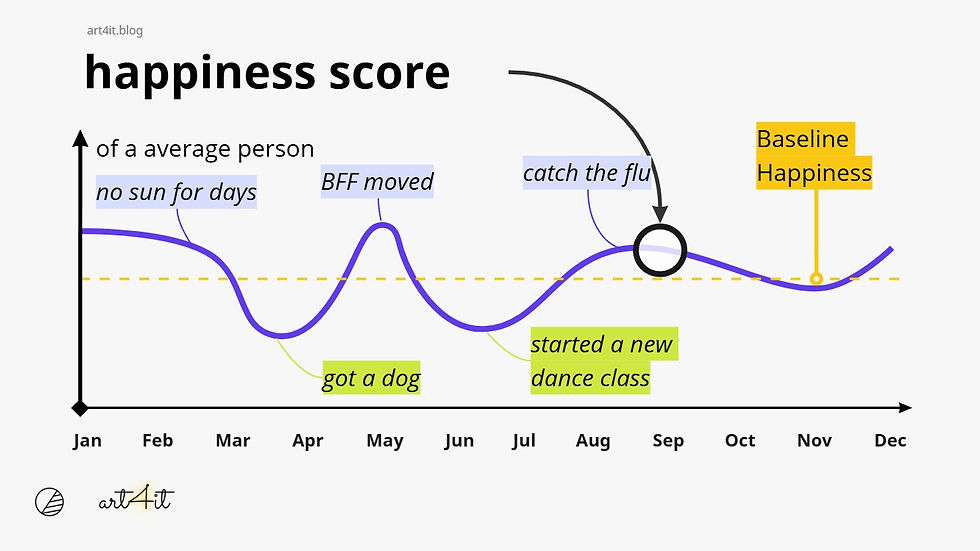Yesterday at the Lowest Point: Winter Solstice mood boost
- M. Art
- Dec 22, 2024
- 3 min read
Updated: Jan 3
Do you want to be happy? Me too.
For the past four years, I’ve been navigating external challenges while diving deep into mental health tools as a marketer. And along the way, I discovered two life-changing truths: 1) Happiness is in our hands. 2) It’s incredibly helpful to prepare for tough times in advance.

Yesterday marked the shortest day of the year in the Northern Hemisphere—a day when many of us felt our energy drained, motivation slipping away, and everything just a bit harder than usual. The reasons for this aren’t just in our heads. As much as we like to think we’re above it, we’re still animals deeply influenced by nature. Even the amount of sunlight we get can affect our emotions, health, and overall well-being.
I’ve learned a few tricks over the years to support myself during the winter’s darkest days. These simple tools have made a huge difference, and I’m excited to share them with you. Let’s explore together.
Let’s Start with the Basics
Our well-being isn’t static; it fluctuates. Think of it as a balance between physical, mental, social, and emotional comfort that creates a sense of fulfillment. Each aspect of life profoundly affects the others daily.

What do modern studies show?
Life has become both more challenging and more exhilarating. Navigating this duality is key. And here’s a hopeful insight: even young people, often under immense pressure, report being happier than other age groups. There’s something to learn from their resilience.
Personal Insights: Happiness on a Personal Scale
Here’s what I’ve learned about happiness through research and reflection:
Baseline Happiness: We each have a default level of happiness, influenced by genetics, upbringing, and environment.
External Factors: How we perceive external events causes our happiness to rise or fall temporarily. Over time, though, we tend to return to our baseline.
What We Can Control: While we can’t change every circumstance, we can shape how we perceive them. By developing resilience, we recover faster from setbacks and savor successes longer.

A Counterintuitive Truth About Winter Blues
Have you ever noticed how 15 degrees feels different in spring versus fall? In spring, it’s a joyful reprieve from winter; in fall, it’s a chilly reminder of the summer’s end. Happiness works the same way. It’s brighter and more vibrant when it follows a decline, and duller when it stagnates. This means winter blues can actually heighten our appreciation for brighter days ahead.
Learning to embrace all emotions—even the less pleasant ones—is a skill worth cultivating. It turns out we can find value in the contrast.
Recommendations for Navigating the Winter Blues from Personal-Development Researchers
Scientists Recommend:
Establish a Daily Routine: Consistency helps stabilize emotions and energy levels.
Get Your Vitamins: Specifically, ensure you’re getting enough Vitamin D to counteract reduced sunlight.
Folk Wisdom:
Embrace Warmth: Hot drinks, cozy blankets, and warm lighting can create comfort.
Stay Connected: Reach out to friends or family to maintain social bonds.
Move Your Body: Even a short walk outside can do wonders for your mood.

The Wisdom of the North: Did you know the happiest people live in the far north? It might seem counterintuitive given their long, dark winters, but they’ve developed a secret weapon: hygge (pronounced "hoo-gah").
This Danish concept of coziness celebrates warm, inviting spaces and meaningful connections. It’s not just the warmth itself that matters but the contrast it provides against the harshness outside. Their appreciation for fireplaces, candles, and soft blankets stems from enduring long, dark winters—a powerful lesson in finding joy through contrast.
Top 5 Tools for Hygge Practices
Candles: Add soft, warm lighting to any space for an instant hygge effect.
Cozy Blankets: Layer textures to create a comforting, inviting atmosphere.
Warm Drinks: Herbal teas, hot cocoa, or mulled wine—perfect companions for cold evenings.
Fireplaces or Candle Alternatives: A focal point for warmth and ambiance.
Journaling: Reflect on daily moments of gratitude to build mindfulness and appreciation.



Comments